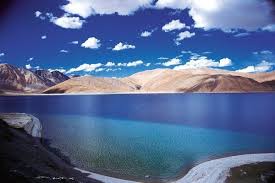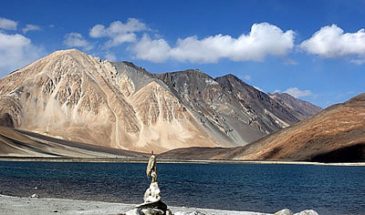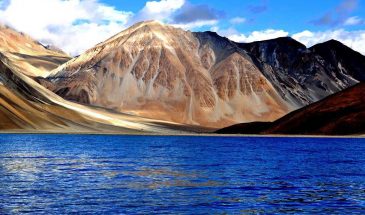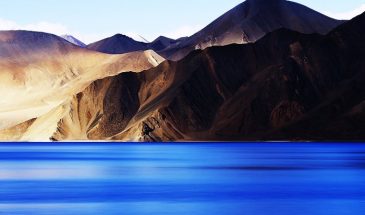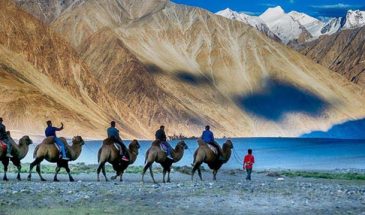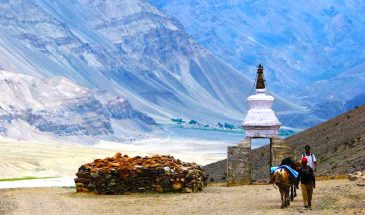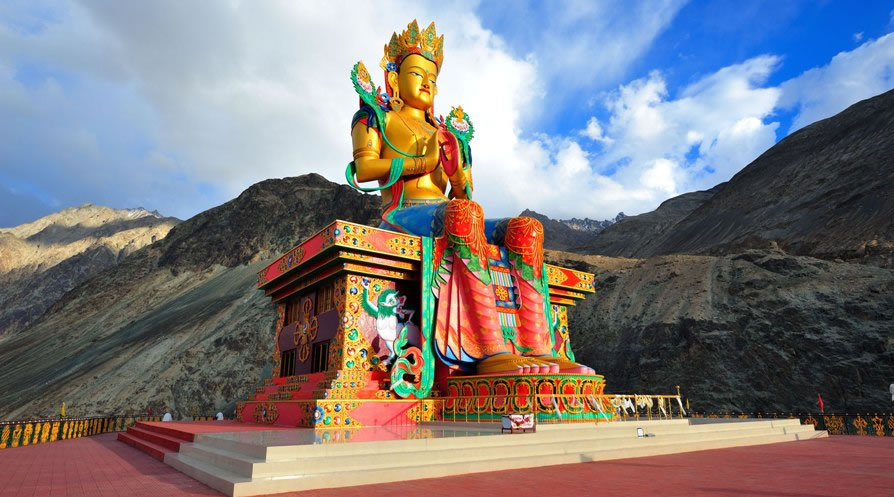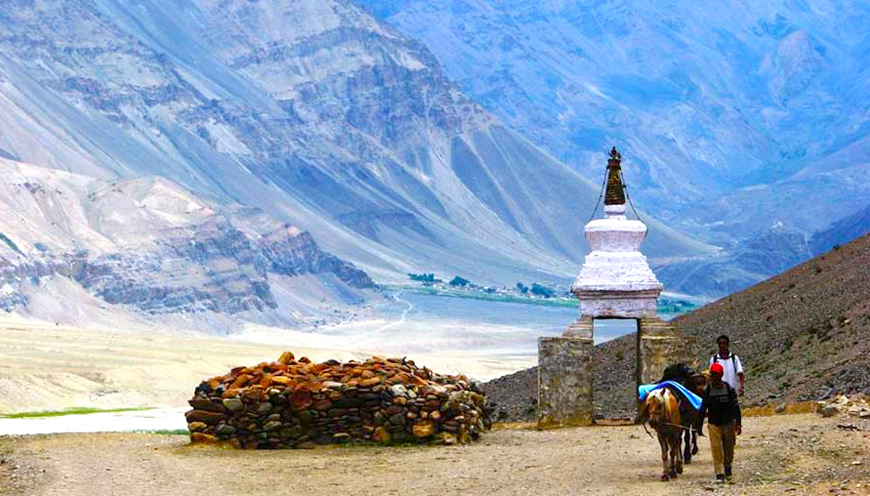Trekking In Ladakh
06 Nights & 07 Days
This Trekking Package covers places Shey, Thiksey, Hemis & Sindhu Ghat, Nubra, Diskit, Hundar, Yangthang, Hemis-Shukpachan, Leh. As you sort through Ladakh tour packages, make sure you round up some of its popular monasteries, palaces, and the old town in Leh.
Ladakh is over 9800 feet that stretches from the Himalayas into the Kunlun Ranges incorporating the fertile upper Indus River basin. After the contemporary borders were drawn up, the plateau of Ladakh came to be flanked by Tibet to the east, the vale of Jammu and Kashmir to the west, Lahaul, and Spiti to the south, and the Karakoram Pass of the Himalayas to the far north. Little wonder, Ladakh turned into a landscape of barren, jagged peaks with picturesque gompas (Buddhist monasteries) perched precariously atop them. The prayer flags in primary colors fluttering alongside only make the all-white dome-shaped stupas stand out in contrast. When the prayer wheel is rotated clockwise, it churns out chants that mingle with the passing wind and produce a melody that is as calming as it is haunting. Home to the monks robed in red, the insides of the gompas are a cheery departure from the stark, ochre, and grey landscape in which it lies. Done up in a riot of colors with intricate murals and bright, golden-hued Buddhas, Ladakh is a piece of Tibet forgotten in time.
Far from being cash-rich, Ladakh’s economy teaches a thing or two to the more commercial economies of the world. Despite living in rural mud-brick homes, an average Ladakhi is self-reliant for the tsampa or roast barley flour, the dairy (yak’s milk, cream, and cheese), and the change or the barley beer that he locally produces. The region is primarily divided into two districts, Kargil and Leh with Kargil forming the Muslim majority, and Leh, Buddhist. While the former is an important stopover on your way from Srinagar to Leh and a port of entry into the Zanskar region, Leh is typically where the tourist activity is concentrated.
Leh: It is perfectly common for travelers to look for Leh Ladakh tour packages because there are hardly so many places that are as tourist-friendly and breathtakingly beautiful as this mountainous district. Hemmed in by a spine of dagger-like ridges, Leh, lying on the Silk Route at 11,490 foot, is a town straight out of a picture book with mud-brick houses, narrow meandering lanes, and an old bazaar at its heart. Also jostling for space are multiple hotels, souvenir shops, travel agencies, and trekking companies that cater to its burgeoning tourist interest. In the long summer months, you can get around to most places within this old town on foot, though the same cannot be said about its harsh winter. Taking it easy at Leh is extremely critical to shed chances of possible altitude sickness later on in the trip when you go on a trek to the higher reaches. The little agricultural hub of Changspa to the northwest of the city has several guesthouses to choose from. Venture deeper into the suburbs and you will enter a lush landscape of barley fields crisscrossed by narrow streams and winding footpaths that typically lead you into somebody’s charming garden home - a bunch of them double up as economical guesthouses.
Sightseeing in Ladakh
A Leh Ladakh trip is incomplete if you do not pay your respects at the various colorful gompas and palaces that surround it.
Leh Palace: A dominant architectural edifice in Leh, the Leh Palace is considered to bear more than a passing resemblance to Tibet’s Potala Palace in Lhasa. Built-in the 17th century under King Singge Namgyal, the structure has remained largely uninhabited since the downfall of Ladakh’s royals. Within the thick walls of the palace, today is a small prayer room, a gallery to hold photo exhibitions, and a staircase leading to the rooftop for a bird’s eye view over Leh’s moon-like landscape. At the base of the structure is the iconic Namgyal Stupa, the Chandazik Gompa with a sweep of vibrant murals, the Soma Gompa, erstwhile home of the monastery’s printing press.
Spituk Gompa: Among the best places to visit in Leh Ladakh is the Spituk Gompa at an elevation of 10,852 foot looking out over the Indus Valley. It is quite unbelievable to watch flights make a landing down below at the Leh airport. You can scale up the staircase to the exterior of the structure to the three-tiered shrine (latho) and the gonkhang believed to be the protector of the chapel. This chapel is home to the monastery’s presiding deities, though women travelers are forbidden from going inside. Once inside the main complex, you will see the most elaborate structure of the Skudung Lhakhang. Head into the old Tibetan prayer hall which has a statue of the founder of Gelukpa Buddhism, the Tsongkhapa. Explore the other ornate statues and find out their fascinating legends before winding up at the little canteen serving traditional Ladakhi tea, paba - a pea and barley meal, and tangtur curry - dip made of greens veggies, and yogurt. About 5 kilometers from central Leh, the gompa holds a festival on the last dates of January.
Leh Old Town: Just beyond the Jamia Masjid in Leh are a labyrinthine of alleys, mud-brick stairways winding up and down old mud-brick houses and stupas that have seen better days. Welcome to the Old Town of Leh. The greatest thrill and charm here is to wind down its maze of alleys, see the old buildings - some have been restored incredibly well, a handsome set of 17th-century structures that presently house the LAMO arts center. Do pay a visit to the Lala’s Art Cafe, then walk past a nondescript passageway depicted by mini-stupas in a combination of blue, yellow, and white. Climb up the rocky slope to LAMO and sit down for some butter tea at the Old Town Cafe before progressing to the Leh Palace above.
LAMO: This 17th-century Ladakhi mansion has been resorted to accommodate the arts and media trust serving as a fascinating backdrop to the art exhibitions, book discussions, and film screenings it holds. You can take a guided 20-minute tour of the place that will give you an account of the architectural uniqueness of the place aside from showing you a portion of the city wall, a false floor panel over a granary. In the early days in order to access barley from the granary, little kids were lowered in on a rope.
Thiksey Gompa: A half-hour drive from Leh is one of Ladakh’s largest and most iconic monasteries, the Thiksey Gompa, perched precariously over a rocky outcrop. Look up its atmospheric prayer hall or dukhang, the giant Buddha figure wearing a crown in the Maitreya temple. But it is truly the quaint old library up on the rooftop predating the rest of the structure, that will hold your attention. The entrance ticket lets you explore the on-site museum as well as some fascinating Buddhist memorabilia. There is a monastery restaurant as well in case you wish to grab a bite before heading out. You can, however, come in time for the prayers that happen between 6:00 am and 07:30 am in the assembly hall.
Yungdrung Gompa: A quick five-minute walk from the Leh Old Town leads you into one of Ladakh’s most photographed Buddhist monasteries, the Yungdrung Gompa in Lamayuru. Inside there is a little alcove that is believed to be the meditation room of a mystic Naropa from 1016-1100 AD. The gompa holds a masked dance festival called Kabgyug in July when the huge rolled-up thangka is emblazoned.
Tsemo Fort: A distinguished landmark in Leh and visible from almost any part of the town, the Tsemo or Victory Fort crowns the Palace Ridge. Outside of a little Buddhist shrine, there isn’t much to browse within the fort walls. Just beneath the gompa are two temple structures from the 15th century; one with an eight-meter-tall statue of Maitreya with a golden-colored face and the other is home to gonkhang (the protector of deities). From Leh Palace, this steep climb to the Tsemo Fort can take about 15 minutes.
Central Asian Museum: Constructed on the lines of a typical Lhasa mansion, this handsome four-story structure in Leh houses the Central Asian Museum for being on an old caravan campsite. Aside from its symbolic significance, the museum explores the role of Leh in the Silk Route trade. There are separate galleries dedicated to Tibet, Ladakh, and Chinese Turkestan. Sharing the courtyard with the museum is the town’s oldest mosque alongside a traditional Ladakhi kitchen where you can sit down to a hot meal.
Sankar Gompa: The main monastery in Upper Leh, Sankar Gompa is a humble two-story structure with a small prayer room comprising a portrait of the former Geluka head lama of Ladakh, the Kushok Bakula Rinpoche. The modest little place is ideal for meditation or for simply soaking up the atmosphere. Even the walk from the Sankar Lane past a stupa-structure is quite calming.
Wanla Gompa: A little over a couple of hours from Leh will bring you to the scenic Wanla village. Atop the Wanla village is a little medieval structure, the Wanla Gompa nestled on a blade-sharp ridge with the towers of a ruined 14th-century fortress rising steeply alongside it. Not just for its carved porch, the gompa is remarkable for its single chamber that comprises three gigantic statues and a spray of murals.
Choskhor Temple Complex: While there are several things to do in Leh Ladakh, you must not miss a trip to the picturesque little village of Alchi known for its monastic complex, about 4 kilometers off the Kargil and Leh road. This 11th-century temple complex holds a treasure of statues and murals dubbed a sterling piece of Indo-Tibetan art in all of Ladakh. Founded by Lotsava Ringchen Zangpo referred to as the ‘Great Translator’, you can find his portrait in the form of a reptile on the back wall of the Lotsa Temple.
Other destinations in Ladakh
Nubra Valley: On the former trade route between Turkestan and Tibet, the extremely fecund Nubra Valley splattered with yak and camel caravans until the Indo-Chinese war of 1967, is today regarded as Ladakh’s own ‘Valley of Flowers’. To the east of the Karakoram Range at an elevation of 10,000 feet above sea level, the Nubra Valley is easily the greenest region in Ladakh. You can get to this ancient caravan route through the Khardung La, the world’s highest motorable road at 18,380 feet. Take in the lush beauty of this high-altitude landscape that opens up a canvas of bubbling brooks, flower gardens, fruit orchards, green pastures, and desert sand dunes. Nubra Valley brings in adventure enthusiasts from across the world who come here in the warmer months to find the valley covered in lavender and rose blossoms. Framed against the backdrop of frosted peaks, the little rambling villages on the hillside and the Buddhist monasteries make for some great photographs. Not to mention, Nubra’s location close to the borders of China and Pakistan, warrants an Inner Line Permit (ILP) before heading into the valley.
Zanskar: One of Ladakh’s extremely remote regions, you need to access Zanskar through Kargil. A part of the inner Himalaya region with extremely low rainfall, Zanskar has a very harsh climate. White-water rafting is extremely popular on the Zanskar with grade 4, 4+, and 5 rapids. Such rafting expeditions are typically organized from Leh. Rafting along the steep gorges of Zanskar is something you will remember for time to come.
Pangong Tso: A definite high-point of your Ladakh visit, the electric blue-colored Pangong Lake at 14,271 foot is surrounded by jagged cliffs. Its location on the Indo-China border makes only a fourth of it falling on the Indian side. The highest saline water lake in the world, Pangong is known for changing colors from blue to green to red. From Leh, it is a five-hour drive on the scenic Chang La Pass at an altitude of 17,798 feet. En route, you can halt at a little camp and enjoy a yak safari. To take some strain off your journey you can opt to stay overnight at Tangtse, a barren little village at 12,959 feet. There are a few hotels and restaurants in the area. It is advised to leave for Pangong from Leh as early as 04:00 am to avoid the treacherous 5 kilometers ahead of the lake where water from melting snow fills up the passage between 01:00 pm and 08:00 pm making it inaccessible.
Popular circuits from Leh
After the initial acclimatization in Leh you will be ready to venture into its higher reaches.
Leh - Karu - Chang La - Tangtse - Pangong Tso and return: This can be done either in a 4X4 or a motorbike where you need to begin very early in the morning and arrive into Pangong before afternoon, before the thawing snow blocks the main passage. You can do a day trip or opt to stay the night close to the lake in Lukung and Spangmik and enjoy a lovely starry night at a camp.
Monasteries around Leh: On a single day you can trek to the major monasteries such as Hemis, Thiksey, Shey, Stok, and Spituk around Leh.
Leh - Upshi - Tso Kar - Tso Moriri: Begin at Leh and explore these lesser-known but extremely atmospheric lakes of Ladakh, Tso Kar, and Tso Moriri. You can halt the night near Tso Moriri at Korzok.
Leh - Khardung La - Nubra Valley: Aside from the bucolic setting of the Nubra Valley, this circuit is preferred by tourists for the stunning views from Khardung La, the highest and most difficult motorable pass. With the Ladakh Range on one side and the Karakoram Range on the other, it makes for a breathtaking panorama. There is enough accommodation available in Nubra Valley and along the way as well.
Leh - Lamayuru and back: A rather easier drive with the Indus River running along on one side in the direction of Kargil. As you drive along, you can witness the confluence of the Zanskar and the Indus Rivers. Outside of being home to Yungdrung Gompa, the oldest and most important monastery in Ladakh, Lamayuru is picturesque. Choose to spend the night in the surrounding village or in the gompa.
Cuisine of Ladakh
With a striking similarity to Tibetan cuisine, the Ladakhi food revolves around a hot bowl of thukpa (noodle soup) and tsampa or ngampe (roasted barley flour) which can be eaten without cooking. Little wonder, it makes for a perfect, non-messy trekking meal. But a staple of Ladakh which is very much its own creation is the skyu, a pasta dish made with root vegetables and milk. The one way Ladakhis have their tea is by adding strong green tea, salt, and butter to the boiling water rendering it with a clear, soupy texture and taste. It might take you a while to get used to this ‘gurgur cha’ courtesy of the bubbling sound the ingredients produce, but you might return home to try it out in your own kitchen. Ladakhis don’t let their surplus barley go to waste as they recycle them into a fermented alcoholic drink called chhang served on special occasions and festivals. In the Main Bazaar, there are several shops selling everyday food catering to tourists such as samosas, chana dal, and puri among a host of sweetmeats. Whether you are in the Leh Old Town or the bus station area, expect Tibetan-style restaurants in the vicinity serving a hearty thukpa and steamed momo. An all-veg meal in this neighborhood may be difficult to come by. Stop by for a baked honey and cheese bread at the German bakery; they have strong coffees as well.
Best time to visit Ladakh
April heralds the beginning of the high season in Ladakh when the tourists gradually trickle in after a long lull of the bitter winter months. Between April and mid-May, you will see the restaurants, the guesthouses, and the hotels opening for business again. Just as the Srinagar-Leh highway opens up by the mid of May, Ladakh receives busloads of tourists and local life picks up momentum again. While the frozen Pangong Tso begins to thaw revealing patches of bright cobalt blue, Chang La and Khardung La still remain under a blanket of snow, throwing open a spectacular white winter landscape.
Monsoon in Ladakh: The rains descend between August and mid-September, giving a new life to the rivers. A terrible time to visit Ladakh because landslides are extremely common in the monsoon.
Most beautiful season to visit Ladakh: If you care for photography and would like to see some primary colors in your natural surroundings, plan a trip between mid-September and mid-October. The lakes are blue, the skies are vivid, the giant dunes glow in all sorts of amber and grey through the day, and the nip in the air is invigorating. You can experience this glory all the way on the Manali to Leh route as well as on the Srinagar to Leh one. More importantly, the roads are back in good nick.
Bone-chilling winter in Ladakh: By the end of October to the middle of November, the cold settles in and sub-zero temperatures become the norm. All restaurants, hotels, and guesthouses, especially the ones above 14,000 feet, shut shop for the season. While the main highways from Manali and Srinagar stay open, traveling on the ice-slick roads can be a risky proposition. Come December and Ladakh gets cut off from the rest of the country because the region goes under several feet of snow. However, places like the Nubra Valley and Pangong Tso stay open for the winter visitors, most of whom are adventure enthusiasts looking forward to the famed Chadar Lake trek that primarily revolves around walking over a frozen Zanskar River. The harsh weather persists until March when frequent snowfall and perpetually falling temperatures make acclimatization tougher.
How to reach Ladakh
The two roads leading to Leh are from Srinagar and Manali and both are equally scenic with narrow winding roads with hairpin bends and of course multiple military checkpoints. Open between June and October, the 434 kilometer stretch from Srinagar to Leh is better for those prone to altitude sickness since it runs through a comparatively lower altitude. Cutting across lush farmlands and quaint villages, it takes two days on a bus to get to Leh with an overnight halt in Kargil. The Manali to Leh route of 473 kilometers on the other hand is largely preferred by the tourists and also takes two days with an overnight stay at Keylong or Sarchu. Besides, a halt at Keylong (10,157 feet) is necessary to cut down the risk of altitude sickness.
By flight: There are year-round flights from Delhi to Leh’s Kushok Bakula Rimpochee Airport. But you need to book a little ahead to keep a buffer period in case your flight is delayed or canceled due to bad weather or to brag Cheap flights earlier. Airlines with operations to Leh include SpiceJet, Air India, Vistara, and GoAir. While GoAir has flights from Srinagar and Mumbai as well, Air India also runs flights from Chandigarh, Jammu, and Srinagar. But if you are arriving by air, you will hardly get enough time to acclimatize; so give yourself a full day’s rest in Leh to get used to the altitude for your travels further up. There are enough pre-paid taxis from the airport to the city center.
By train: The railway station closest to Leh is Chandigarh and Pathankot, and from both these points it is approximately three days by bus to Leh. Udhampur connected by rail to Jammu is another point of entry into Ladakh.
By motorbike: The Manali to Leh route is extremely popular with bikers. You can rent a motorbike in Manali; there are several bike rental companies around the main Mall Road with their fleet of Royal Enfields and Pulsars. A typical itinerary from Manali weaves around Jispa at 110 kilometers on day 1, Pang at 130 kilometers on day 2, and Leh another 130 kilometers on day 3. A popular motorbiking circuit from Delhi includes Delhi - Chandigarh - Manali - Sarchu - Pang - Leh, and a second one which encircles Delhi - Ambala - Jalandhar - Patni Top - Srinagar - Kargil - Leh. To ride a motorcycle to Leh, pick the months between June and early October when the roads are open and less treacherous, and the passing scenery is spectacular.
By bus: Several states as well as privately-owned deluxe buses run from Manali to Leh with a night halt in Keylong. There are Himachal Road Transport Corporation (HRTC) buses from Srinagar to Leh, just as there are several Himachal Pradesh Tourist Development Corporation (HPTDC) buses from Manali to Leh. While it is possible to book tickets for a Delhi to Leh journey, but you would be less prone to mountain sickness if you halted in Manali and then in Lahaul or Jispa at an elevation of 10,170 feet.
By jeep: You can even hitch a ride on one of the many shared jeeps running between Manali and Leh. These take about 24 hours to get you to your destination as opposed to the longer bus tours. Be mindful that acclimatization doesn’t really happen on such a journey and you could have a terrible bout of altitude sickness on getting up there. While the journey can be extremely uncomfortable, the scenery would be unparalleled, particularly if you are sitting beside the driver. Jeeps can be privately hired too for a more memorable journey allowing you to set your own pace to get to Leh. You can hire jeeps from Srinagar as well to take you to Leh.
Accommodations: ‘A’ Class Hotel /Resort / Camp.
Package Price (PP): (Minimum of 02 pax)
Day1:
Arrival and transfer to Hotel. Complete rest for acclimatization.
Day2:
Visit monasteries, Shey, Thiksey, Hemis & Sindhu Ghat. Overnight hotel.
Day3:
Visit Nubra Valley.
Day4:
After visiting Diskit, Hundar drives back to Leh.
Day5:
Drive to Yangthang. Start trek towards Hemis-Shukpachan. Nice village and landscape.Camp at Hemis-Shukpachan.
Day6:
Drive back to Leh after breakfast. On the way see Magnetic Hill, Gurudwara Pather Sahib.
Day7: Transfer airport, dep.
Itineraries
Day 1
Your Plan
Arrival and transfer to Hotel. Complete rest for acclimatization.
Day 2
Your Plan
Visit monasteries, Shey, Thiksey, Hemis & Sindhu Ghat. Over night hotel.
Day 3
Your Plan
Visit Nubra Valley.
Day 4
Your Plan
After visiting Diskit, Hundar drive back to Leh.
Day 5
Your Plan
Drive to Yangthang. Start trek towards Hemis-Shukpachan. Nice village and landscape.Camp at Hemis-Shukpachan.
Day 6
Your Plan
Drive back to Leh after break fast. On the way see Magnetic Hill, Gurdawara Pather Sahib.
- Welcome, Drink on Arrival.
- Accommodation on MAP Plan (Breakfast & 01 meal on twin sharing).
- Transportation to all places mentioned by non-AC Vehicle.
- Permits to a restricted area.
- Any Kind of Personal Expenses or Optional Tours / Extra Meals ordered
- Camel Safari Charges/ Cable car charges/ entrance to Monasteries.
- Any Kind of Drinks (Alcoholic, Mineral, Aerated)
- Tips, Insurance, Laundry, Phone Calls.
- Cost incidental to any change in the itinerary/stay on account of flight cancellation due to bad weather, ill health, roadblocks, and/or any factors beyond control on any circumstances.
July and August are the definite peak months to visit Ladakh when all roads and passes are open. The weather is nippy with a sunny morning and afternoon making it fit for exploration. Expect the mercury to go up to 25 degree Celsius and fall to about 10 degree Celsius post sunset. For bikers too this is the best time to visit and experience all the wonderful colours the place is splashed in. Also the time when the popular Hemis Festival takes place.
Give yourself a couple of days - but at best a day, before moving out to the higher reaches. Not only does Leh have an array of monasteries, palaces and other sightseeing spots, it will also let you acclimatise better when you go further up to a Nubra Valley or Chang La.
There are several shared as well as private jeeps running the 470-odd kilometres from Manali to Leh. Though shared jeep rides come cheap, they can be tad uncomfortable given the length of the journey which is nearly 24 hours with little scope to acclimatise. While the front seat-view (beside the driver) is enviable and puts you as close to the natural surroundings as possible, those on the back seat can have a rather bumpy, uneven ride and suffer motion sickness.
Himachal Road Transport Corporation (HRTC) has direct buses from Delhi to Leh, leaving New Delhi’s ISBT Kashmere Gate daily at 02:30 pm and arriving into Leh in about 35 hours. To cover the 1050 kilometre, the bus halts overnight at Keylong before moving ahead to Leh. The bus route is Delhi to Chandigarh to Kullu and via Rohtang Pass to Keylong before arriving in Leh. The bus makes several pit-stops along the way for food and drink and lets you soak up the stunning scenery.
Souvenir hunters have plenty of opportunities afoot in Leh’s Main Bazaar home to an assortment of curio shops selling Tibetan antiques, trinkets among other bric-a-brac. You can head into the Tibetan market to pick up unique silver jewellery, Pashmina shawls. There are several bookstores in Leh with a superb array of novels, travel books, guide books, and books on the Himalayas and Buddhism. Just by the jeep stand is a second-hand clothing market selling warm winter clothing, in case you desperately need to get yourself one. But if you have a trek planned out, do round up the trekking food shops selling powdered milk, instant noodles, chocolate, biscuit, granola bars and some dry fruits.
Pangong Tso at an altitude of 14,271 foot affords a dramatic mountain scenery that is starkly beautiful. In order to get to the blue-coloured Pangong Lake from Leh, you need to begin at the break of dawn so that you get there before noon. Typically it is a five-hour journey through the picturesque Chang La Pass, but the later you start more the difficulty in reaching the lake site since the road gets blocked by water from melting snow trickling in around 01:00 pm up until 08:00 pm. However, you do not have to return on the same day from Leh; you can stay the night at a guesthouse or hotel in the Tangtse village close to Pangong.
Yes, you need an ILP to visit Nubra Valley because it is close to the borders of Pakistan and China. It is easy to attain an ILP permit these days as you can go to the official ILP website, enter your details, furnish your identification proof, state the purpose of your journey and you will be issued an e-ILP. You need to produce a printout of the same at the site.
Though the Indian Army keeps the world’s highest motorable road open through the year, it may not necessarily be possible to travel all year round. The best time to enjoy the beauty of the landscape and drive through is between April and June and then from September to October. The monsoon months in between make the stretch extremely treacherous, and in the months post November it goes under a blanket of snow. The road opens at 09:00 am and shuts by 05:00 pm everyday.
The Himachal Pradesh Tourist Development Corporation (HPTDC) buses take about 2 days to get to Leh from Manali. The 473 kilometre stretch warrants a night stay in Keylong or Sarchu before progressing to Leh. The road is extremely scenic and the slow pace of the journey helps you acclimatise better.
While Ladakhi is a Tibetan dialect and can be difficult for a traveller to fathom, you can get around locally by speaking in Hindi and also English, courtesy the surge of foreign tourists. Across Leh, most people speak and understand Hindi and even English, but when you travel remotely into the villages, no other language but Ladakhi is spoken and understood. Keep the word ‘julley’ - a greeting in Ladakhi - handy and you can win both favour and friends.
Jammu Kashmir Road Transport Corporation (JKRTC) has direct buses from Srinagar to Leh, leaving from TRC Srinagar, via Sonmarg, Zojela Pass, Kargil
